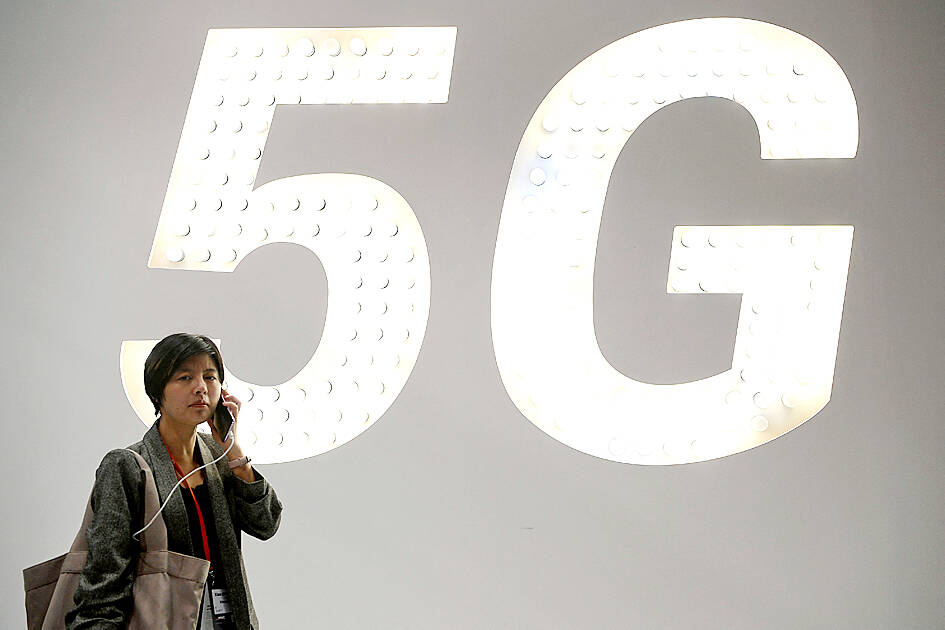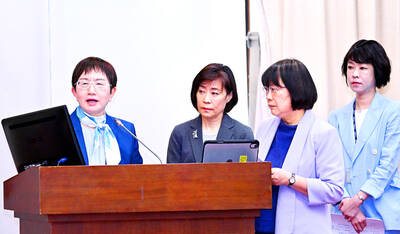The nation’s major telecoms on Tuesday posted robust revenue for last year, as growth in mobile 5G subscriptions helped boost average revenue per user (ARPU).
Chunghwa Telecom Co (中華電信) reported that revenue expand 3 percent annually to NT$216.74 billion (US$7.12 billion) last year, surpassing the company’s high-end projection of NT$214 billion.
Net profit rose 2.1 percent to NT$36.52 billion last year, beating its estimate of NT$36.04 billion and reaching its highest level in about four years, it said.

Photo: AFP
Earnings per share (EPS) rose to NT$4.71 last year from NT$2.1 in 2021.
“Rises in ARPU for the mobile and fixed-line businesses helped boost the company’s net profits,” Chunghwa Telecom chairman Sheih Chi-mau (謝繼茂) said in a statement. “Additionally, 5G-based information-and-communications projects also helped.”
Last month, mobile ARPU rose 5 percent annually, the 21st month of increases, which Chunghwa Telecom attributed to a rise in 5G subscribers. The company did not disclose its number of 5G subscribers.
Taiwan Mobile Co (台灣大哥大) said that revenue last year expanded 10 percent year-on-year to an all-time high of NT$172.21 billion.
The firm’s e-commerce subsidiary Memo.com Inc (富邦媒體), one of its major growth engines, saw revenue soar 17 percent to more than NT$103.44 billion last year.
Net profit rose 0.36 percent to NT$11.03 billion from 2021. EPS edged higher to NT$3.91 from NT$3.9 a year earlier, it said.
“The upgrade to 5G services and exclusive mobile packages helped boost the company’s mobile ARPU 1.8 percent annually to NT$662 million in December, for 19 months of increases,” Taiwan Mobile chief financial officer George Chang (張家麒) said in a statement.
As a result, mobile service revenue expanded 3.3 percent annually last month to NT$394.4 billion, hitting the highest level in three years, Chang said.
Far EasTone Telecommunications Co (遠傳電信) said that revenue last year increased 4.5 percent from a year earlier to NT$89.15 billion, after mobile service revenue climbed 2.9 percent to NT$49.82 billion in the year and growth in 5G mobile users drove up its ARPU 3.6 percent from a year earlier.
Net profit rose 5.3 percent to NT$9.61 billion from NT$9.12 billion in 2021, with EPS expanding from NT$2.8 to NT$2.95, the firm said.

‘SWASTICAR’: Tesla CEO Elon Musk’s close association with Donald Trump has prompted opponents to brand him a ‘Nazi’ and resulted in a dramatic drop in sales Demonstrators descended on Tesla Inc dealerships across the US, and in Europe and Canada on Saturday to protest company chief Elon Musk, who has amassed extraordinary power as a top adviser to US President Donald Trump. Waving signs with messages such as “Musk is stealing our money” and “Reclaim our country,” the protests largely took place peacefully following fiery episodes of vandalism on Tesla vehicles, dealerships and other facilities in recent weeks that US officials have denounced as terrorism. Hundreds rallied on Saturday outside the Tesla dealership in Manhattan. Some blasted Musk, the world’s richest man, while others demanded the shuttering of his

TIGHT-LIPPED: UMC said it had no merger plans at the moment, after Nikkei Asia reported that the firm and GlobalFoundries were considering restarting merger talks United Microelectronics Corp (UMC, 聯電), the world’s No. 4 contract chipmaker, yesterday launched a new US$5 billion 12-inch chip factory in Singapore as part of its latest effort to diversify its manufacturing footprint amid growing geopolitical risks. The new factory, adjacent to UMC’s existing Singapore fab in the Pasir Res Wafer Fab Park, is scheduled to enter volume production next year, utilizing mature 22-nanometer and 28-nanometer process technologies, UMC said in a statement. The company plans to invest US$5 billion during the first phase of the new fab, which would have an installed capacity of 30,000 12-inch wafers per month, it said. The

Taiwan’s official purchasing managers’ index (PMI) last month rose 0.2 percentage points to 54.2, in a second consecutive month of expansion, thanks to front-loading demand intended to avoid potential US tariff hikes, the Chung-Hua Institution for Economic Research (CIER, 中華經濟研究院) said yesterday. While short-term demand appeared robust, uncertainties rose due to US President Donald Trump’s unpredictable trade policy, CIER president Lien Hsien-ming (連賢明) told a news conference in Taipei. Taiwan’s economy this year would be characterized by high-level fluctuations and the volatility would be wilder than most expect, Lien said Demand for electronics, particularly semiconductors, continues to benefit from US technology giants’ effort

Minister of Finance Chuang Tsui-yun (莊翠雲) yesterday told lawmakers that she “would not speculate,” but a “response plan” has been prepared in case Taiwan is targeted by US President Donald Trump’s reciprocal tariffs, which are to be announced on Wednesday next week. The Trump administration, including US Secretary of the Treasury Scott Bessent, has said that much of the proposed reciprocal tariffs would focus on the 15 countries that have the highest trade surpluses with the US. Bessent has referred to those countries as the “dirty 15,” but has not named them. Last year, Taiwan’s US$73.9 billion trade surplus with the US